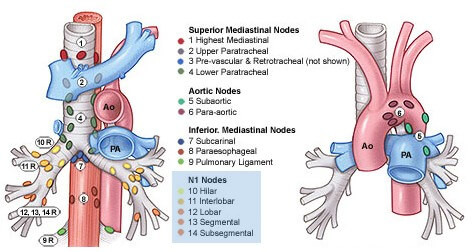The current staging system is recommended for the classification of both non–small cell and small cell lung carcinomas and for carcinoid tumors of the lung .
TNM Staging of Lung Cancer
Primary Tumor (T)
The “T” staging of bronchogenic carcinoma is a bit complex compared to others. Five things must be checked before assigning a T classification. They can be remembered with a mnemonic: ABCDE.
- Atelectasis
- Bronchus involvement (bronchoscopy)
- Contiguous conquer (Adjacent site invasion)
- Diameter in cm
- Elevated nodules
Chest wall involvement as in breast cancer denotes advanced T stage.
| Diameter (cm) | Bronchoscopy (Main bronchus involvement) | Atelectasis or Obstructive pneumonia | Invasion | Nodules | |
| T1 | A – ≤2 cm | ||||
| B – 2 to ≤3 cm | |||||
| T2 | A – 3 to ≤5 cm | ≥2 cm distal to carina | Lobar | Visceral pleura | |
| B – 5 to ≤7 cm | |||||
| T3 | >7 cm | <2 cm distal to carina | Whole lung | Chest wall (including pancoast or superior sulcus tumor), Diaphragm, Phrenic nerve, Mediastinal or parietal pleura | Same lung lobe |
| T4 | Any size | Carina | Heart, great vessels, trachea, esophagus, recurrent laryngeal nerve spine, | Different ipsilateral lung lobe |
Regional Lymph Nodes (N)
- N1: Ipsilateral – Peribronchial, hilar or intrapulmonary nodes
- N2: Ipsilateral – Mediastinal or subcarinal nodes
- N3:
- Contralateral – Mediastinal or Hilar (N1 and N2 if ipsilateral)
- Ipsilateral or Contralateral: Scalene or Supraclavicular nodes
Metastasis (M)
M1:
- a – Separate tumor nodule in contralateral lung lobe (T4 if on ipsilateral lobe), Pleural nodules, Malignant pleural or pericardial effusion
- b – Distant Metastasis
AJCC Staging of Lung Cancer
The staging of lung cancer is similar to another thoracic tumor – breast cancer. In both of these sites, the primary drainage nodes (N1) is close to the involved site, hence, T1=N1.
- M stage is a separate stage: M1 = Stage IV
- N stage determines stage group I-III
- N3 = Stage IIIB
- N2 = Stage IIIA except with T4 (Stage III B)
- T stage modifies substages:
- T4 = Stage IIIB
- T1 or T2 N0 = Stage IA or IB respectively
- T1 or T2 N1 = Stage IIA or IIB respectively



Great content and information. Knowing the staging of lung cancer and its TNM is very necessary if someone is having doubts about having lung cancer.